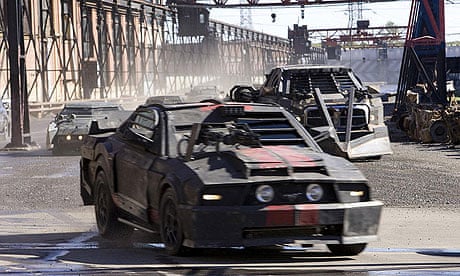In Death Race, there are people, and there are cars, and the two entities are really, really similar. People smash into people; cars smash into cars. Sometimes cars smash into people. I suppose there is a difference – the cars don't talk to each other, or spit in each other's food. But when the people in this film talk to each other, they might as well be revving their engines or honking their horns. There isn't very much character development.
To be fair, there is a bit. There isn't absolutely none.
The film is based on Death Race 2000, a movie made in the 1970s about a future dystopia in which people raced to the death. One interesting thing is that, in those days, people imagined that this particular dystopian future would take two and a half decades to arrive. But this version is set in 2012 – these days, we're much more impatient.
I settled down in the cinema, which was about a quarter full, and sipped at my coffee. There was a sense that we were not expecting anything too great.
In the film, Jason Statham is an ex-racing driver. He has stopped driving for, I think, some dark reason I didn't catch, possibly because there's a lot of background noise in this movie. Maybe he's killed somebody on the track. Maybe he's just "lost it". He's called Jensen Ames – named after the Jensen Interceptor, a classic sports car. He is lavishly, although not densely, tattooed – a tormented fighter rather than a heavy metal geek. He is "cool". He has no discernible emotions. There is nothing very complicated under the bonnet.
Anyway, he gets put in prison.
The dystopia is as follows. People in prison have a choice. They can either stay in prison or they can race to the death, in mad cars, and win their freedom. (At least, that's the deal offered by the prison's icy governess, played by Joan Allen. But is she being honest?) Meanwhile, these death races are America's most popular sport, with huge ratings, and the whole thing absolutely stinks with corruption. If you want a much more nuanced version of this type of thing – manly men, corrupt sport, and a sexy, bossy woman in charge – check out Oliver Stone's film about American football, Any Given Sunday.
But back to this film. What does Statham do? Of course, he decides to risk racing to the death. You'd think, as an ex-racing driver, he would jump at the chance, but he doesn't – he broods for a while. But then he decides that, yes, he'll race to the death. This is the bit of character development I mentioned earlier.
Did I say that he's in prison having been framed for murdering his wife? Well, that's the situation. He minds about this, but not overly. Just like he minds when people try to kill him, but not overly. He is sentient. But barely.
When he gets to prison, he somehow scores a woman straight from the pages of a lads' mag as his co-driver. Again, he seems neither pleased nor displeased.
And then ... the races begin!
For me, this is where the film loses its grip. You'd think that racing to the death would be pretty exciting, wouldn't you? But it's not. The reason for this is that you don't care who dies, because none of the characters seem to be alive in the first place. Still, there's a great deal of crashing, and people in grave danger, and people dying, and the vague, nagging worry that the Joan Allen character might not be telling the truth when she tells Statham that he'll go free if he wins the race.
But you know what the scariest bit is? It's when someone spits in Statham's food. Which, I think, is pretty significant. Given that this is a film about racing to the death.
